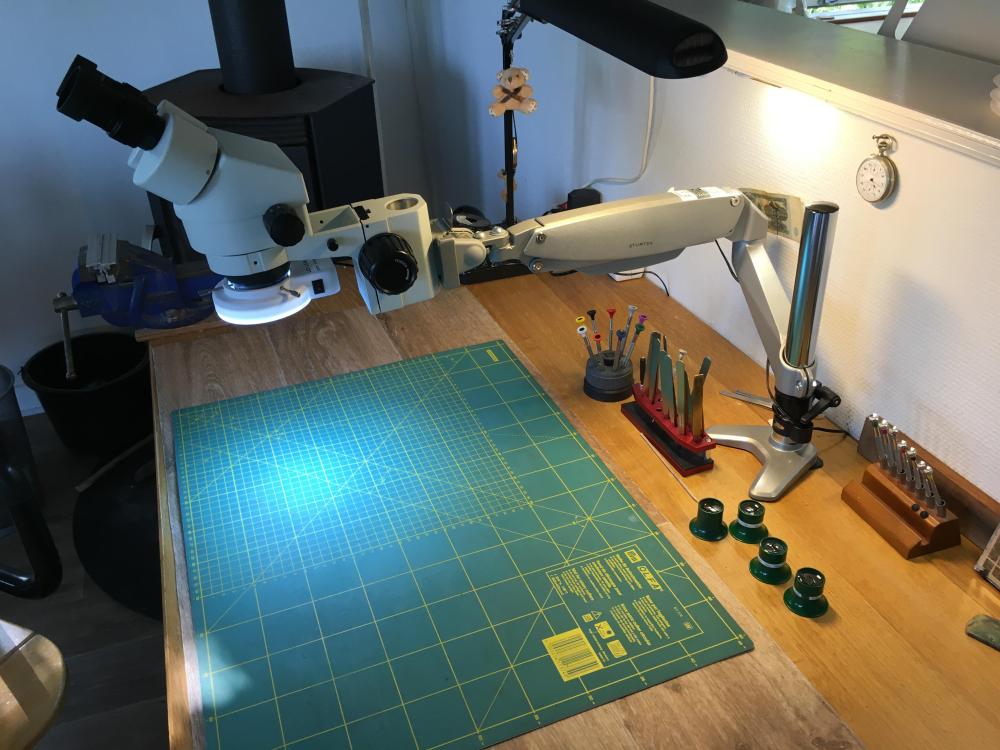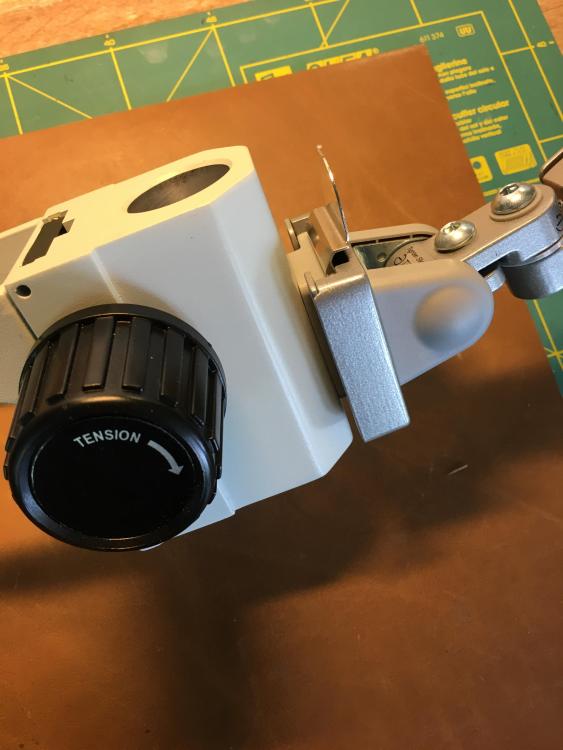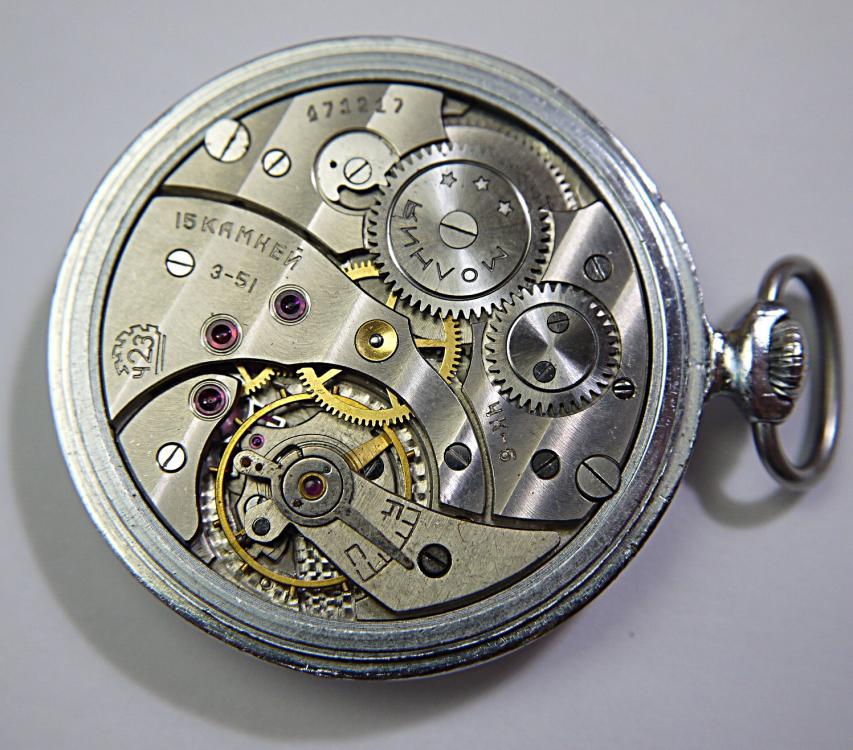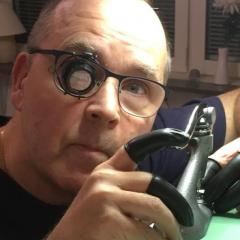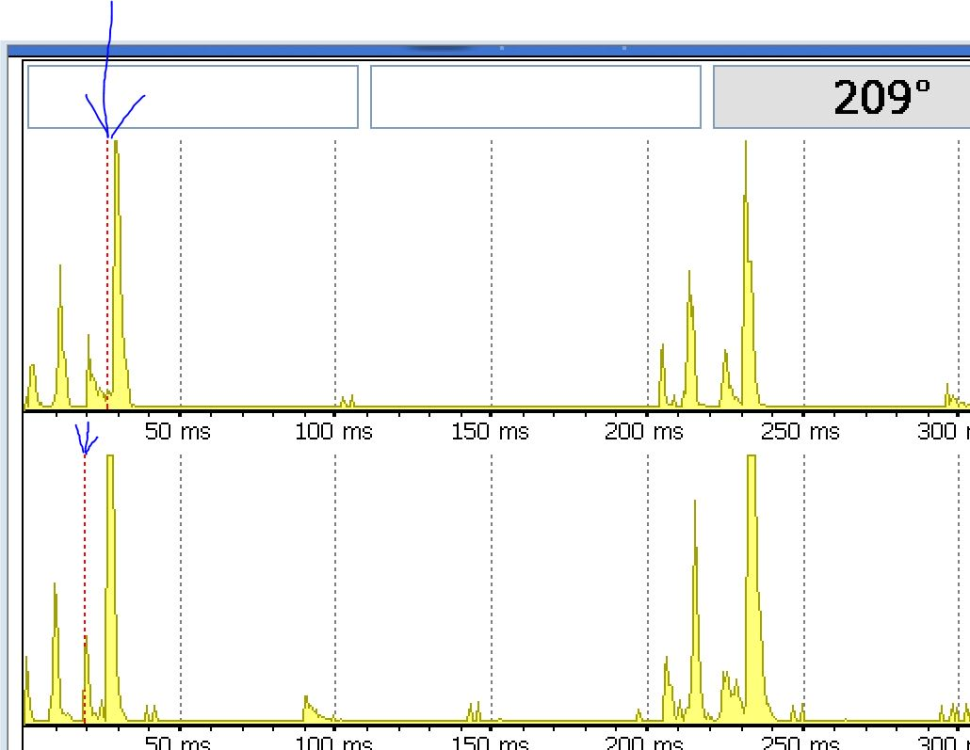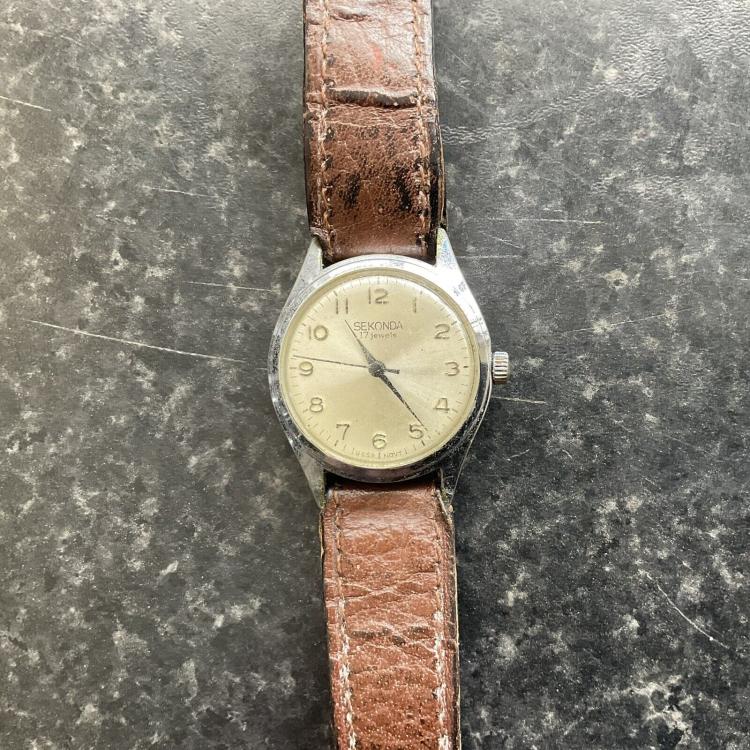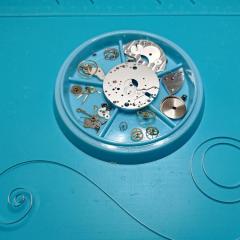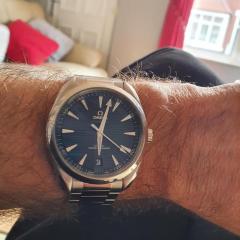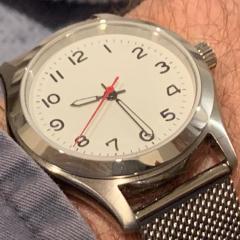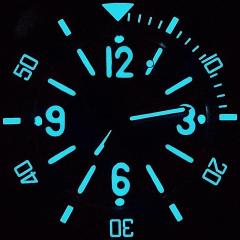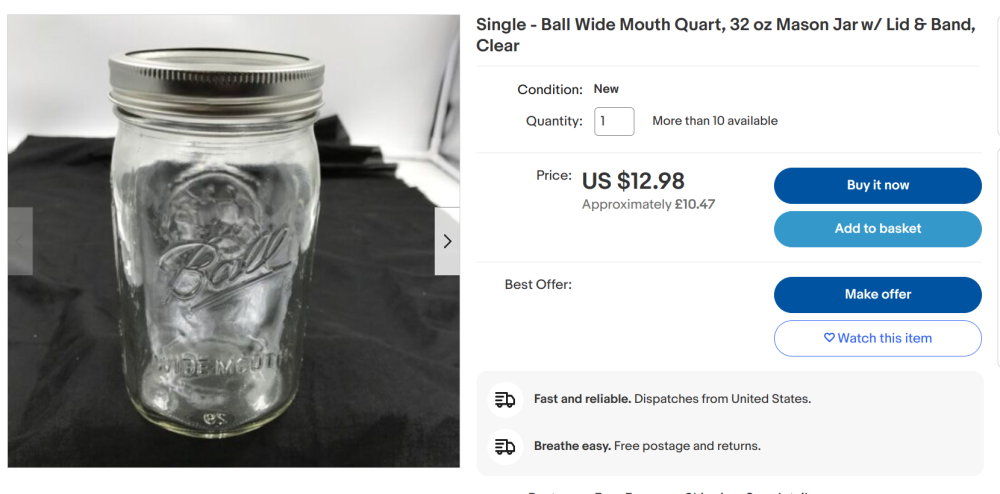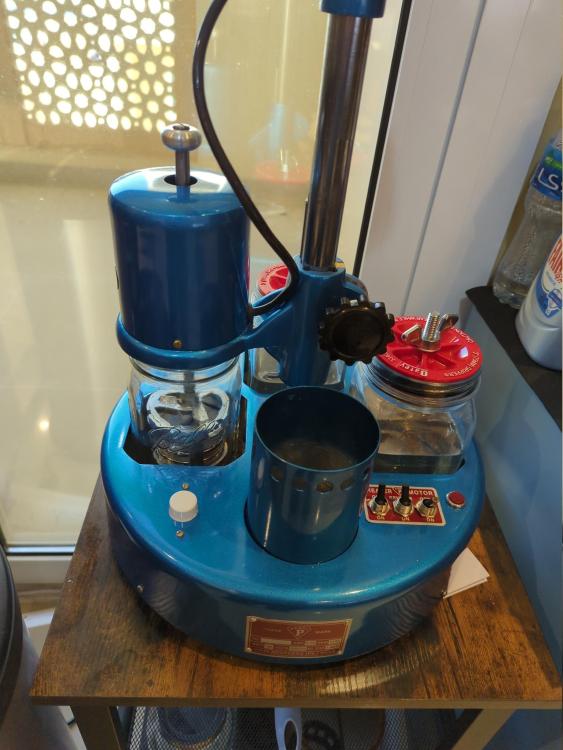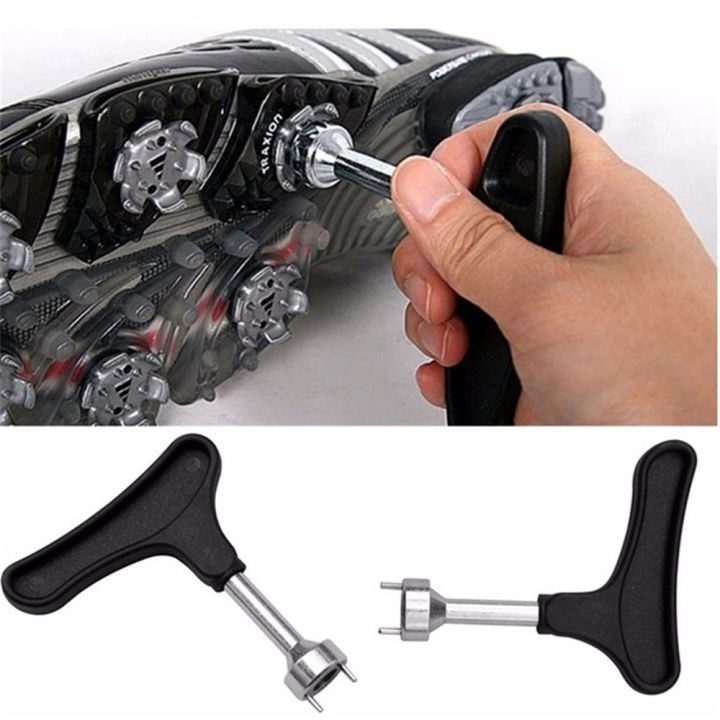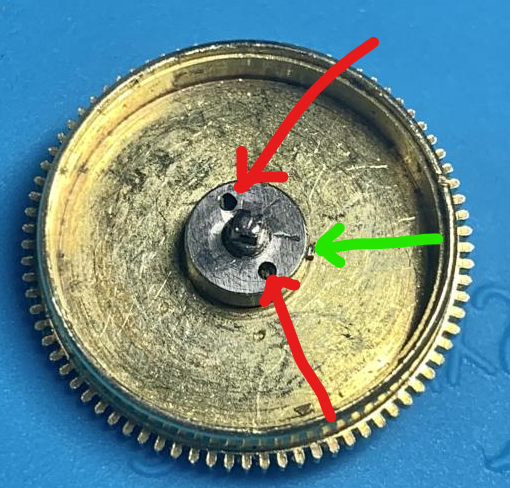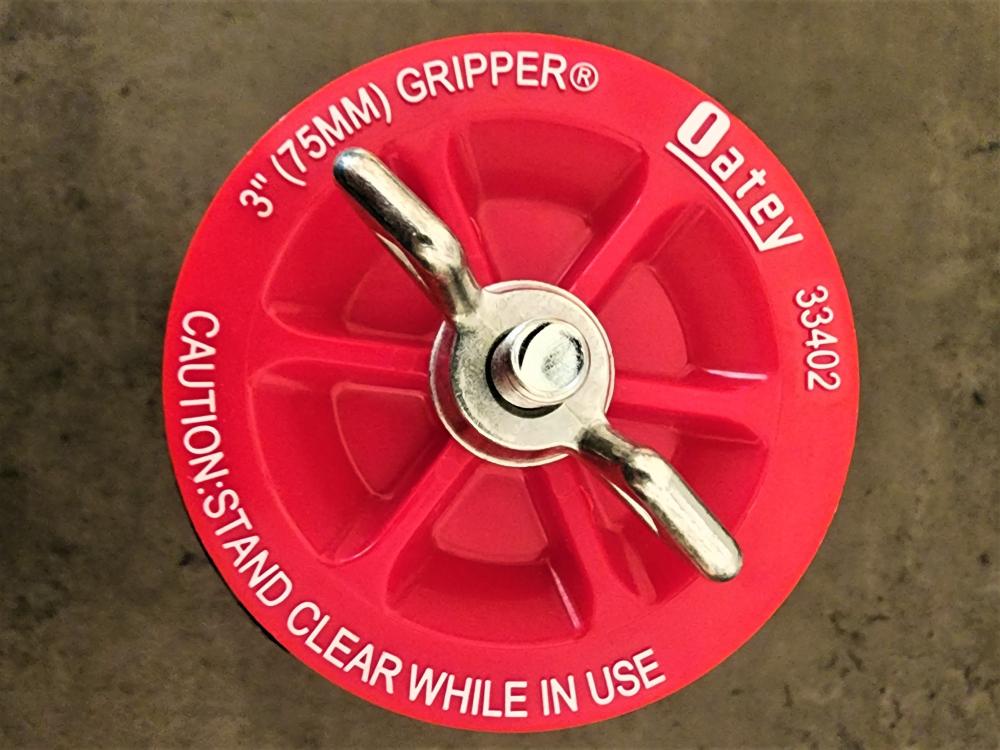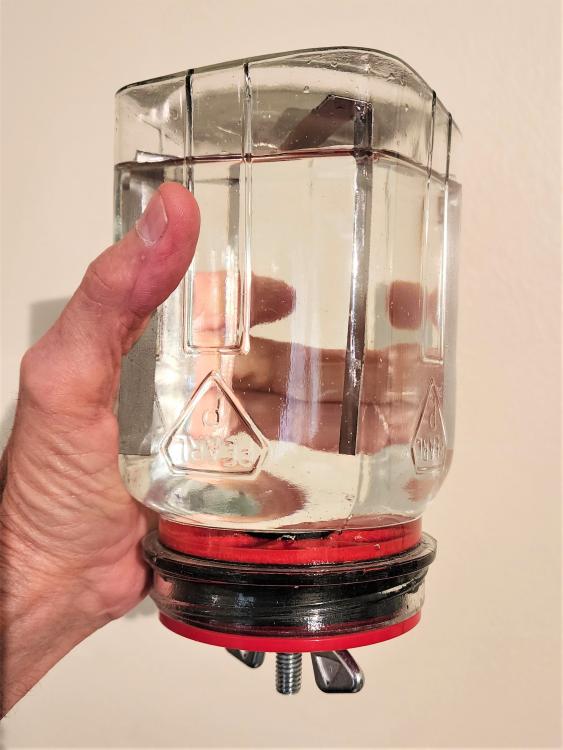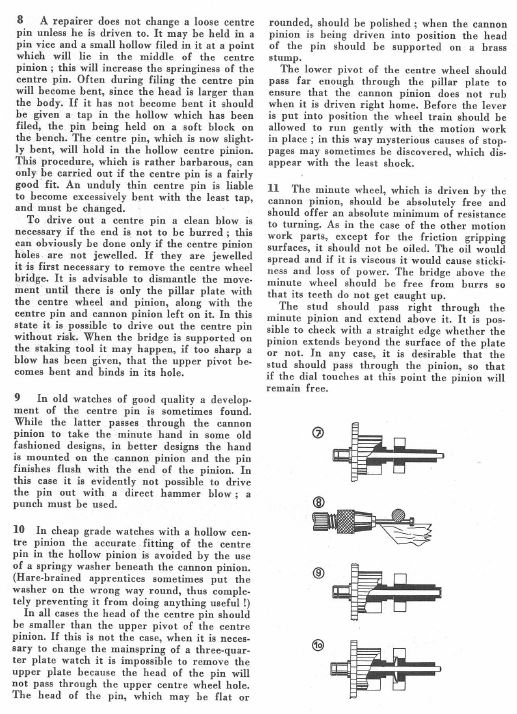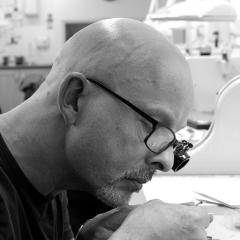Leaderboard
Popular Content
Showing content with the highest reputation on 05/26/23 in all areas
-
For the people interested, I like follow up and conclude my monitor-arm experiment. The new gas-spring monitor arm (Atumtec ATMS032) was purchased of eBay for the grand sum of €47.50, including shipping. The back of the Vesa plate had a plastic bracket which allows the screen to be uncoupled from the monitor arm. Instead of following the idea in the video given earlier in this thread, I saw opportunities with this plastic bracket. That plastic bracket (with two M6 holes) fitted nicely to the back of the microscope bracket. The microscope bracket had already one M8 hole in it, so it required drilling one more hole and to cut M6 thread in it. The other hole in the plastic bracket was enlarged to allow a M8. To make sure that the plastic bracket wouldn't crack, due to its hollow inside, washers were used to fill the gap. This all worked according to plan; Combined a nice tight fit with the monitor arm; Installed the monitor-stand to the table, electricity for the ring light, mounted the microscope and adjusted the gas-spring tension. With the monitor-stand positioned roughly in the middle of my work-desk, a large area can be covered, and the microscope can be swung out of the way when not needed. Now the big question: Does it work !? For me, YES it does !! Is the arm rock-solid? No, the arm is not rock solid. But with the 0.5x Barlow lens it works quite well. Much better than I had anticipated. When adjusting the height of the microscope with the big knob or adjusting the magnification, yes the arm "wobbles" a bit, but one can still see clear and adjust clear. Having no reference to an expensive microscope arm, I doubt whether my setup "wobbles" a whole lot more than such an arm. I would love to hear from people, who have such an expensive arm, whether these are rock solid when adjusting the knobs? Once you've adjusted the height and magnification, the monitor arm comes quickly to a rest and the view is crystal clear. The picture will start to shake if you bang the desk with a hammer, but by which arm it wouldn't? If I need the microscope on its "original" base, all I need to do it to uncouple the microscope from the monitor-arm, remove the plastic bracket (2x screws) and it's ready to be installed on the original base. The only alteration done to the original setup was adding one M6 hole. Perhaps the official arms are better (?), but you have to grab much deeper into your pocket. For me, I don't see any reason for purchasing anything else, as it works very well. Off to my next Endeavor4 points
-
A lot of people don't know but there are quite a few, what you call "cheap industrial style" watches who have in fact a movement from Swiss origin. So is the Poljot 3133 chronograph a Valjoux 7734. The Soviet people actually improved the beat from 18,000 to 21,600 BPH. The Molnija 3602 is a Cortebert 624 movement, earlier used by Rolex as well. If you take for example an early version (1949 to about 1958/59), these movements are beautifully made, complete with Geneva stripes (I own a few prime examples). The date of the one in the picture 3-51 stands for 3rd quarter 1951. Very beautiful and robust movement. The Poljot 3017 is based upon the Venus 175, and probably the list goes on and on. I owned and worked on many Soviet/Russian watches, predominately Vostok, Poljot chronographs and Molnija pocket-watches, so I can't say much about all the other brands, of which there are many such as Raketa, Luch, Prim etc, etc. My experience, from the 3x brands I've been working on, is that the best quality movements are from the Soviet period. The Poljot 3133 movement was in my opinion good till in the 1990's. Poljot went burst in early 2000, others took over such as MakTime, but the quality went downhill. Same with Molnija, good movements till in the early '90's, even though the Geneva stripes disappeared already after the 1950's. There are very nice movements to be get, be it often in a different taste of wrapping. If you haven't been into Russian watches jet, you missed out on a lot A small warning; the Soviet / Russian watch-world is a totally different ball-game, it's a kind of (very exciting) wild-west and you need to know what you are doing / buying. Many sellers with beautiful blue eyes.3 points
-
Well, when I first started coming across Breguet hairsprings, it was in Soviet movements, and I would say I didn't expect it and was very surprised, but I've since then learned that it isn't all that unusual. Not sure why I didn't expect it and was surprised. Maybe it is the result of the, dare I say it, western propaganda that the Russians are generally incompetent. Still, in reality, they excel in many fields such as aviation, space, weapon systems (for example their Missile Defence System), medicine, and science in general. So, why not in horology when and if they want to? Anyway, it is important to remember that the Soviet horological industry was not about satisfying a marketplace but instead mainly about providing timekeeping for the masses in a practical form. We can see this Russian approach in many fields. For example, the AK-47 isn't known to be a weapon of precision but instead made to be inexpensive, reliable, and practical, but I have no doubt that they have the competence to achieve what they need and want. If you Google it you'll find many articles about it. Here's one short intro: https://www.breguet.com/en/history/inventions/breguet-balance-spring#2 points
-
Anchor brand belongs to Cambridge time spares in Mumbai. They are wholesalers and supply Cousins and others. I bought from them many years ago, shipping was costly then. Maybe they sell to end users today, an email request may show. CTS is one of the serious sellers who look (a bit) on quality. But eventually they are merchants, no watchmakers. Frank2 points
-
Neat old watch that's showing its age in a rather charming way. Still, I'm sure it would be nice to clean up a bit and have it running well. The bridge layout is so common that it may be difficult to nail down a maker. The best hope may be to have the dial removed to see the keyless works. Then again, it's probably quite early to be certain of its inclusion into the various "fingerprint" diagrams. Still, there might be a marking on the pillar plate under the dial that could help with ID. Be aware that the hands and numerals are almost certainly radium and have surprisingly strong radioactivity. You don't want to handle them roughly at all. Your watchmaker, should you enlist the services of one, should know all about radium. Good luck getting better info. Cheers.1 point
-
yes I clicked on the link I did find it amusing they do have a watch repair section and this isn't the watch repairs section. One of the complaints I have with message boards are there's too many places to hide messages and then finding them becomes impossible unless somebody points them out. the problem with timing machines are they have limitations. All of the timing machines will have limitations if they cannot get a good clean signal. Most of the 1000 machines don't have a gain setting which can be a problem. The 1900 and most witschi machines do have volume settings regains settings but there's only so much you can do. so if you have a heavy case possibly with a chronograph running the timing machines are going to have a really hard time getting a clean signal. I believe the person said it took more than a minute for the machine to figure out what it was seeing and that is definitely a clue to a problem. If the timing machine can't pick up that really quiet roller jewel hitting the fork then what is it picking up? Everything is dependent upon the roller jewel hitting the fork if you start picking up another part of the signal or sometimes especially if the amplitude is really low then the timing machine isn't sure where the locking occurs in other words it occurs beyond worth looking then you'll see really high amplitudes like this person is seeing when a real life it's not a high amplitude. It's back to the reality of visually looking at the watch what does the amplitude look like. Looking at the graphical display make sure it looks clean and nice they can still be fast or slow but it has to yet the bill a recognize the lines it can't look like a snow globe as somebody else on this group likes to call it. Snow globe effect is very back. If you looked at the signals on his pictures looked at the video they looked a little on the rough side. Then of course the numbers have to agree with the graphical display and what you're seeing on the. In real life there's probably nothing wrong with the timing machine and there's nothing wrong with the watch it's just it's not picking up a good clean signal. let me give you a picture of the problem. This comes from the witschi machine at work as you can see from the upper and lower our oscilloscope traces there's a problem. The dashed red line is where the machine thinks it should be triggering from. The upper red line isn't quite where I think it should be but it's much closer than the lower line. Notice on the lower I oscilloscope traced it things the wrong part of the waveform is what it should trigger from. If you are looking at the numeric display or if we had a video you would see an alternating between the amplitude it shows which would be the upper one and then the other one would be much higher so you see this altering of amplitudes because of the wrong signal. So yes even a machine that cost about $10,000 can get confused. But at least with the oscilloscope I can see why it's confused.1 point
-
This one arrived, and looks promising. I couldn't remove the case back, which is actually a good sign, as it means that there is a high probability that nobody else has been tinkering inside it. I had to resort to supergluing a nut to it, as I was afraid that my case back openers were going to mar it. Once inside, it all looks pretty untouched, but somewhat filthy. The dial looks to be in good shape though, and a spot of lubrication and a wind proved that it will run. I'll strip it down, service it and post the results when I've finished EDIT: I was wrong with my guess about what was likely to be in it, it contains a Bostok 2209. A USSR produced 17 jewel movement from some time after 1955. Not what I thought it would be, nor was it a Pobeda (Победа) K-26 movement, the first watch movement ever in space, which would have been even more interesting. Since it is branded Sekonda, it must be some time after 1966, but judging by the late 1950s design cues and the 16mm lug width, probably nearer 1966 than the 1970s. The original "Sekonda” watch brand was a company set up in 1966 by “Chasprom” the USSR watch industry central agency who’s remit was to sell their Russian made watches to a wider audience.1 point
-
Go on to this site. https://www.time2timepiece.co.uk/imported-products-12/rolex-10-12-ligne-vintage-watch-movemnet-237-mm-diameter-15-jewels-swiss-made If not exactly the same caliber, its a variant of your piece.1 point
-
i bought a pack of small neodymium magnets (they come in different strengths and sizes) and fitted them (using their own magnetism) to an old metal letter opener. I then use this to sweep around the floor (I also have carpeting) and into the nooks and crannies. I can add or detach individual magnets to adjust strength. You can also sweep your clothing and hair/beard!! I have just used it in the garden when repairing some fences to delve through the soil to find the driver bit which went awal.!! You'll have to demag the part you find by this method before fitting to watch etc. If non-magnetic or the above fails to find the item, then the old brush and pan to sweep the floor can be very successful. If item is magnetic then a poke around with the magnet in the sweepings may find it. After that, it is wrap some gaffa tape round your hand (sticky side out, of course) and roll your way round the floor etc. Then inspect with eyeglass or scope. Found many a cap jewel this way.1 point
-
Hello Everyone, my name is Sean. I've been a hobbyist for a couple years and recently signed up for Mark's classes to polish my skills a bit. I have focused primarily on American pocket watches so far. Their history is so much fun to me. I have a drawer full awaiting restoration, as well as a few projects for friends and family.1 point
-
1 point
-
1 point
-
I have the single boom stand, and it swings out of the way when not being used. This is an interesting concept. I forget how much the stock Amscope stand was, but I'm sure this solution is significantly less. Being that you should not be putting your forehead on the eye pieces, being rock steady I don't thing is a huge problem. The arm on mine is rock solid, but you are correct, if you pound your fist on the desk, it will cause it to shake. It does not change the altitude over the piece... that would be the only thing that might concern me with the arm setup you have. Do you find that you need to adjust it say 24 hours later due to it going lower? I wouldn't think so as the head of the microscope is not all that heavy (all the weight is in the base and arm). The one thing I didn't see in your write-up, and maybe I missed it, is can you adjust the head tilt? Meaning, can you tilt it toward you so the lens is looking more towards the middle to back of your work area? The only way I can do that with mine is to put the base off to the side, but then the main arm tends to slip and rotate in the joint. I'm sure if I got a set of channel locks out and really cranked it down I could get it to stop doing that, but that is the biggest frustration for me. Currently I don't have it set on the side and have it just straing ahead like you have yours. I now just tilt whatever I am working on a little when I need to use a screwdriver and the problem is solved.1 point
-
Indeed! Those look very interesting (and vintage)! Love the brass/bronze construction -- softer than barrel arbor makes good sense. Kind of a long shot given how old these look, but any idea where these may be obtained?1 point
-
Great solution fo you. Best of both worlds. My double arm boom stand is rock solid, but I don't have to move it very often. Moving the stand is a great way to do weight training exercise1 point
-
I dont think its a case of moving away from that design. Its just a hallmark of better quality watches and ones that require a more accurate timekeeping are more likely to have an overcoil spring. Grand Seiko is an example of that.1 point
-
1 point
-
I have a pearl machine and use these Ball jars: Make sure you get the 'wide mouth'" version and not the standard version. As you can see from the below they fit well on the machine: A little tighter on the jar opening, but still goes in no problem with room to spare: Substitute Ball jar on the left and original Pearl jar on the right: Also as you can see from my pictures I took @jimzzillareccommendation and use the plumbers 3" test caps which fit the pearl and Ball jars. Hope this helps1 point
-
interesting that picture looks just like one other solar watches? Also looks like you're disassembling it while it's still in the case that's going to be an issue for you. Then one of the problems with the existing documentation PDF format is often times it came into existence for parts service was an afterthought. But I did find something for you 2691_Citizen 8625,8626,8627,8628,8629-1.pdf1 point
-
With the balance stationary, when you move the regulator left or right, it should be able to travel the whole length without touching the hairspring. If you observe the hairspring moving when you move the regulator, the hairspring is distorted. Check that first before we move on.1 point
-
no pictures? we like to see pictures. In particular a watch repair discussion group we like pictures of movements. oh and I'm confused it's not the solar caliber but yet it has the same number? https://www.crazywatches.pl/citizen-crystron-8620-solar-quartz-19761 point
-
you would think a company that's proud enough to put their name on the products might put a link to where we could find them. Oh and another product they make is lubrication is very popular because it's very inexpensive. It also has really interesting properties for lubrication but who cares it's really inexpensive. Maybe they really don't want their customers to find out where they live. My best understanding is anchor is a product of India I don't suppose India registers trademarks you might find them that way.1 point
-
Can't you let the hairspring out? Clocks with this type of regulator including all carriage type it is common practice that the regulator is set near or on the middle. There is a reason why it is gaining so much but if you find it, what you are saying is your only way then go ahead but it will look odd to the eye. Has it a good action, as this can cause problems, check the balance pivots, they should be as sharp as a new pencil, how about the two jewels they must be clean are they cracked or chipped.1 point
-
Eyup waggy. These are the ones that i picked up a few weeks ago. Not from cousins but from someone on ebay that had bought them and pulled from the trays what they wanted for arts and crafts. I cant exactly comment on what would have been in them originally, but what i received were predominately HMT in particular calibres that were Citizen copies. But there were others inc. Some swiss. A break down would be 40 % Indian, 30 % Chinese, 10 % Russian , 10 % Swiss and 10 % Japanese. For what i paid and i did get something like 15 Kg was very little. I am not even a quarter of the way through sorting and have spent hours and hours so up to now. Over a thousand barrels complete ( if only to practice winding in a mainspring ) probably 500 balance shock settings, literally thousands of jewels to choose and pick from. Keyless works, screws, clicks sprins hands crowns stems cap jewel plates ( which helped restore a watch already ). For me the material alone to make parts from was well worth it as i said i got such a lot for very little. But there is so much more in the way of stock, i dont know how much is interchangeable yet but some of it may be very usable with most movements. Things like the screws hands springs jewels etc. Unfortunately there were no balance wheels , i was hoping for timing screws and washers so this maybe what the original buyer of them has used. I was in the throws of making another post to recommend these to embryo watchmakers . They are a fantastic way to improve hand dexterity and learn the handling of parts and manipulation of tools. I've always been pretty good with this from the start, my first month of the hobby i bought something similar but all quartz movements a bucket load of them. Stripping them apart was like an intense crash course on tweezer and screwdriver manipulation. These boxes can achieve the same goal, as an example after hours of sorting yesterday and becoming rather bored. Every now and then i would find a rough looking shock setting and strip it down. I like a good challenge so i timed myself on eight different settings i found ( some very unusual ). The task was to release the shock spring lift or remove it depending on its design take out the cap jewel spin it over 180° put it on the bench spin it over again pop it back in and reinstall the spring. I ranged from 32 seconds for an incablock to just under two minutes for a wierd looking inca copy that had front tabs that had to be released twisted and lifted and then slid out from the back end. This was a single handed shock removal the other hand held the cock down with a finger. No Rodico, no pegwood assistance no breakages and most importantly no pinging, just one pair of dressed and polished no.5 titanium tweezers alternated with a bent accuncture needle to tweek the spring's tabs if needed ( some were quite rusty so i was also being careful not to break them ). I will put only 40 % of that result down to skill the main contributer to this was confidence. Knowing if i broke or lost the spring that it didn't matter in the slightest gave me a massive edge in my challenge. So i can highly recommend a box of this material even if its just for some intensive nerve free practice. So enjoy the ride any newbies reading this as it seems we can actually buy a skill and ego boosting experience now. Cool .1 point
-
Those 2 holes (red arrows) in the arbor remind me of a golf shoe spike (see below) - not suggesting an actual golf spike tool would work .... but maybe this is the mechanism that is used to install it? I think your best option is to hand wind in the spring and then make sure that the hole in the end of the spring fits over the stud sticking out of the arbor (green arrow). It may be difficult to hand wind with the arbor in the way, but maybe a better option than damaging the arbor or barrel trying to remove and then reinstall the arbor?1 point
-
Sadly the owner of this website has (most likely) passed and his website disappeared. Luckily, somebody is hosting (I think a WUS Russian-forum member) a mirror (for as long as it last). Tons and tons of invaluable (need to know) information regarding the Poljot 3133: https://www.mfkrlives.com/polmax3133/ WUS has a really good Russian-watch section: https://www.watchuseek.com/forums/russian-watches.10/ Even though I'm not a member anymore, you may still see my forum name popping up1 point
-
Janta jar dimensions.... 3 3/4" X 3 3/4" square X 6 3/8" Tall. Inside mouth diameter is 3 3/16" I do not know if Janta will sell them, they can be hard to deal with and the gaskets in the lids do not completely seal so there is odor and evaporation. The gasket stops about 3/4" from touching itself. I used plumbers 3" test caps for the lids.1 point
-
Not in the least bit. A lot of those cheap industrial industrial style Russian Raketa's, Poljot's, etc. were also equipped with Breguet overcoil hair springs.1 point
-
@RickTockThis is an excellent topic and thank you for posting it. It has answered a number of questions I have had…and more tools I might want to get sooner rather than later. All I have is a cheap pin vise, so seeing and hearing the differences between the pin vise vs barrel arbor holder is good to note and informative. as always, this forums members are so helpful with all their knowledge.1 point
-
I recently acquired a Marshall PEERLESS in very good condition without jars. It appears the Pearl/Janta jars will likely fit. Can someone provide info on a source for these jars? Thank you!1 point
-
Don't straighten the pin, the bend is intentional. The friction between the bent pin and the inside of the center wheel arbor is what provides the coupling friction for the train to turn the hands. On this type of movement the canon pinion and the pin rotate together. If you straighten out the pin you will uncouple the hands from the movement and they won't turn.1 point
-
to understand what you're dealing with I have images snipped out of a book. it was a little bit older it would've been much easier to spot. Because the early ones would been key set and it becomes quite obvious that things don't quite look right well sort of usually if I see anyone struggling with I can't take the cannon pinion off especially in older watch then this is usually the problem and yes when you look at the other side it would've been nice for more pictures but yes you can recognize the style even without seeing everything. But a lot of times people would ask ahead of time if things don't seem right.1 point
-
Below is a link discussing in great details the issues with polywatch and older cellulose crystals together with several methods to clean them and other types of crystal. Unfortunately I think it is too late for your crystal, but at least you will know for next time As an aside I use Autosol acrylic paste, which I have found to work just as well as polywatch (I think its pretty much the same stuff - just in a bigger cheaper tube):1 point
-
One of the more "interesting" properties of some older clear plastic objects (and this includes old film stock, and some old watch crystals) is that they are made from nitrocellulose. Of course this makes them interesting in a similar way to the way that radium dials are interesting. They have a certain level of mild peril associated with them. Nitrocellulose is the main component of old fashioned "gun cotton" explosive. Nitrocellulose film stock for this reason is notorious for spontaneous combustion, and furthermore for being almost impossible to extinguish, since it contains its own oxidizer. The reason more recent types of film stock are called 'safety film' is because they don't have this rather inconvenient property. With this in mind, and if you are up for a small and mildly hazardous experiment, you might want to replace the yellowed crystal with a modern alternative, and then try burning the old one. If it burns rapidly and rather alarmingly, then it is made from nitrocellulose. If it melts and burns rather poorly, then it is a more modern acetate based crystal. The usual caveats apply, you obviously do this entirely at your own risk. Don't forget to film the results. Burning down your entire neighbourhood may well net you a viral video. You can thank me afterwards.1 point
-
I've got to concur with @MarcIt is more than likely a cellulose compound the crystal is made from. If it had a yellow sheen to it and had some serious age to it, then it's very probable. There is nothing you can do to resurrect this one, I'm afraid. Always best to replace one, as you can't even see through some of the really bad ones , unless it isn't too bad then you might want to keep the originality of the timepiece. Some will have their views on patina of dials and hands, etc. Personally, I like to see some history that has been etched into the watch case; not necessarily the acrylic though. I do like to give an original acrylic a polish to remove the major scratches by starting off with some 1200 grit wet and dry, or powder charged on a cotton bud, then go through various grit counts to end up using something like cerium oxide as a finish. I find original acrylic crystals, say from the 60's or 70's have a nicer smoother rounder profile than the modern day ones which are a bit blocky in my opinion.1 point





